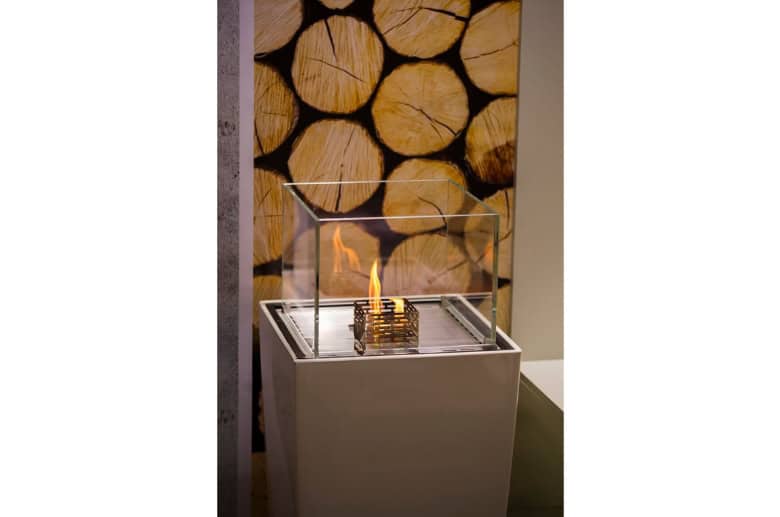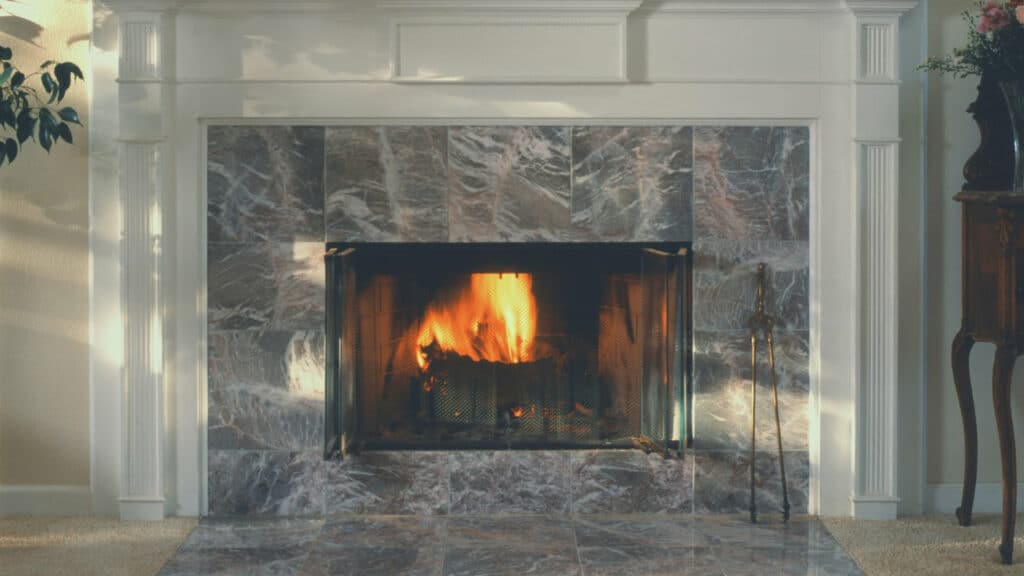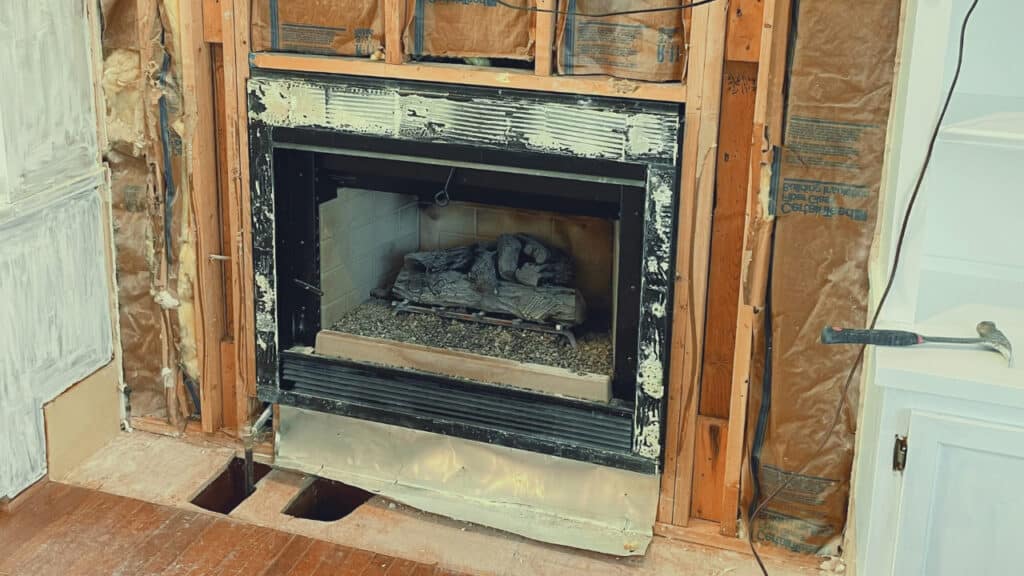Bioethanol fireplaces have gained popularity in recent years as a sustainable and aesthetically pleasing heating option. They’re eco-friendly, easy to install and operate, and versatile in design, so it’s no wonder many homeowners opt to have them at home.

In this article, we’ll learn more about what is a bioethanol fireplaces, how they work, and what ethanol fuel is made of. We’ll also examine the benefits of having this fireplace in your home and the safety guidelines to follow when using it indoors. Lastly, we’ll discuss the different types of bioethanol fireplaces and some considerations to make when buying one for your home.
What Is A Bioethanol Fireplace?
Ethanol fireplaces utilize bioethanol, a renewable liquid fuel produced from agricultural by-products. This type of fireplace doesn’t require a chimney or vent, as it emits a minimal amount of carbon dioxide and water vapor when burning, making it nearly smokeless and odorless.
It is made primarily from plant materials known as biomass or bioenergy crops. These crops include sugarcane, corn, wheat, barley, and other agricultural products that can be fermented to produce alcohol.
Bioethanol is produced by fermenting the sugar components of plant materials to create ethanol, a type of alcohol. After fermentation, the ethanol is distilled and purified to increase its concentration, making it suitable for use as fuel. The final product, bioethanol, is a clear liquid that burns cleanly, producing heat, water vapor, and carbon dioxide.
——
Do You Need to Hire Chimney & Fireplace Expert?
Get free quotes from qualified experts near you. No commitment required!
——
Benefits of Bioethanol Fireplaces
Bioethanol fireplaces offer a range of benefits that make them a popular heating choice for homes. Here are just some of the benefits homeowners enjoy with bioethanol fireplaces:
Eco-friendly
Bioethanol is produced from plant byproducts, making it a renewable and sustainable energy source. Its combustion process releases minimal greenhouse gases, primarily water vapor and carbon dioxide, in amounts similar to human breath. Thus, bioethanol has significantly less environmental impact than traditional fossil fuels.
No chimney or vent is required
Bioethanol fireplaces burn clean, meaning they don’t produce soot, smoke, or ash. It means you don’t need a chimney or a vent to have a fire. This feature significantly simplifies the installation process, broadens the possibilities for fireplace placement in your home, and helps you maintain indoor air quality.
Versatile design

Bioethanol fireplaces come in a wide array of design options, from wall-mounted units to freestanding models. This versatility makes it suitable for various interior styles and settings, enhancing the aesthetic appeal of any style of home.
Easy installation and use
Bioethanol fireplaces are easy to install, often requiring no more than setting the unit in place and filling it with bioethanol fuel. This makes them a cost-effective option for homeowners. Their operation is also straightforward, with no need to handle firewood, coal, or complicated wiring. They’re also quite easy to maintain, with minimal cleaning required.
Health and Safety
Because bioethanol fireplaces burn clean, you reduce the risk of compromising your indoor air quality. It does not emit particulate matter and other pollutants like traditional wood or coal-burning fireplaces. Moreover, many bioethanol fireplace models come equipped with safety features to prevent spills and regulate flame.
Cost-effective installation and operation
Without the need for a chimney or a flue, it’s easy to install a bioethanol fireplace since it has minimal structural requirements. This makes it less expensive than traditional options. Although the cost of bioethanol fuel is a consideration, the overall expense can be balanced by the low maintenance and operation costs.
Portability
Some bioethanol fireplace models are portable, which means you can move them between rooms or even outdoors.
Regulatory compliant
In urban areas or regions with strict air quality regulations, bioethanol fireplaces offer a viable alternative to traditional fireplaces, which may be restricted due to pollution concerns.
Considerations for Choosing an Ethanol Fireplace
When choosing an ethanol fireplace, several important considerations should be made. You want to make sure that it meets your aesthetic preferences, practical needs, and safety standards.
- Ventilation: The number one consideration when getting an ethanol fireplace is the room’s ventilation. Even though ethanol fireplaces produce less harmful fumes than traditional fireplaces, they still consume oxygen and release carbon dioxide and water vapor into the air. Make sure that the room is well-ventilated to maintain air quality and prevent the buildup of gas.

- Size and heat output: Size and heat output are other factors to consider. How warm do you need the room to be? How will the fireplace be used? For heating, ambiance, or both? Ethanol fireplaces come in various sizes and heat outputs. To avoid overheating or insufficient warmth, select one that is appropriate for your space.
- Design and style: These should also be considered when choosing a fireplace. Fireplaces come in a wide range of designs, from traditional to modern. Consider your home’s style and the look you want to achieve.
- Fuel efficiency and running costs: Check the fuel efficiency of different bioethanol fireplace models and the cost of fuel in your area. Ethanol fireplaces may be convenient and eco-friendly, but the cost of fuel is higher due to production and distribution costs, as well as market demand and availability.
- Safety features: Pick a fireplace with safety features such as spill-proof burners, automatic shut-off mechanisms, and sturdy construction materials. These are crucial for preventing fire hazards and accidents.
- Installation requirements: Most ethanol fireplaces are freestanding and portable, requiring minimal installation. However, other models, such as wall-mounted or built-in, may require professional installation. Before making a decision, consider the complexity and cost of installation.
- Quality and durability: It’s worth investing your money in a fireplace made of high-quality materials. This ensures it is durable and will last with you for many years to come. Opt for a fireplace with stainless steel components since this is resistant to the high heat generated by the fire.
Safety Considerations for Indoor Ethanol Fireplaces
Having an indoor ethanol fireplace requires careful attention to minimize risks. Here are some best safety practices to follow if you have one in your home.
- Use only quality bioethanol fuel. The wrong type of fuel can increase the risk of harmful emissions or even cause dangerous consumption. Store bioethanol fuel in a cool, dry place away from the fireplace and out of the reach of children and pets. Ethanol is highly flammable, so proper storage is important to avoid accidents.
- Keep furniture, curtains, and other potentially flammable items away from the fireplace. A minimum clearance of 50 to 60 cm above the fire opening is a good idea. The recommended clearance for the sides is between 5 and 10 cm.
- Install smoke and CO detectors, as this is critical for any home with combustion appliances. Test these regularly to ensure they work properly.
- Never leave an ethanol fireplace unattended. Extinguish the flame before you leave the room or go to sleep. If you have children or pets, keep them out of the fireplace or supervise them when the fireplace is in use. A safety barrier helps prevent accidental contact with flames and hot surfaces.
- Have extinguishing tools nearby. Ethanol fireplaces come with a snuffer, which is designed to extinguish flame without the risk of splashing fuel or causing burns. Familiarize yourself with using the extinguisher or baking soda when trying to deal with a fuel spill or an unexpected flame.
- Ensure the fireplace is installed according to the manufacturer’s guidelines. Regularly inspect it for wear and tear and promptly address any maintenance issues. Always follow the manufacturer’s instructions for filling, lighting, and extinguishing the fire. This includes using the recommended amount of fuel and not overfilling the burner.
——
Do You Need to Hire Chimney & Fireplace Expert?
Get free quotes from qualified experts near you. No commitment required!
——
Types of Ethanol Fireplaces
Ethanol fireplaces come in different types to suit different needs and preferences, ranging from indoor models to outdoor models. Here is an overview of the different types of ethanol fireplaces available in the market.
Tabletop Bioethanol Fireplaces
Tabletop ethanol fireplaces are small, portable units that can be placed on any stable surface, such as a dining table, coffee table, or outdoor patio. This type of fireplace is ideal for adding instant ambiance to any space. Its size and portability make it perfect for both indoor and outdoor use. No installation is required. You can easily move it from one location to another.
Freestanding Bioethanol Fireplaces
A freestanding ethanol fireplace is a self-contained unit that can be placed anywhere in the room without installation against a wall or an existing fireplace structure. This type comes in various shapes and sizes, from models that resemble traditional wood-burning stoves to contemporary designs that serve as modern artworks.
Its portability allows for easy relocation within a space or between rooms. This fireplace can be your central source of heat or a decorative element in your home. It does not require installation, but it should be placed on a stable, fireproof surface away from flammable materials.
Wall Mounted Ethanol Fireplaces

Wall-mounted ethanol fireplaces are attached to the wall, similar to a flat-screen TV or a piece of wall art. It’s ideal if you’re trying to save floor space but still want that warmth and ambiance of a fireplace. Models range from compact units to expansive designs. Its installation is generally straightforward. You only need to make sure it’s securely mounted to the wall.
Built-In Ethanol Fireplaces
Built-in ethanol fireplaces are integrated directly into a wall or custom cabinetry. This gives it a seamless look, making it appear to be part of the room’s architecture. These installations can be tailored to fit any space, from expansive living room walls to compact bedroom nooks.
The great thing about this type of fireplace is that it can increase the value of your home. It’s perfect for creating a permanent heating solution without taking up additional space. You can get a design that matches your room’s aesthetic from minimalist to luxurious.
Outdoor Ethanol Fireplaces

Outdoor ethanol fireplaces are designed to withstand weather elements. These can range from freestanding models and firepits to wall-mounted units and tabletop designs. What all these have in common is their durability and flexibility of placement. They don’t require a gas line or electrical connection, so you can enjoy them anywhere in your outdoor living space, like the patio, deck, or garden.
Ethanol Fire Inserts
The ethanol fireplace insert is designed to fit into existing traditional fireplaces, converting them into clean-burning ethanol units. It comes in various sizes and can easily be installed in the firebox of a wood or gas fireplace.
If you have an unused or inefficient traditional fireplace, you can repurpose it with an ethanol fireplace insert. This allows you to maintain the traditional fireplace aesthetic while benefiting from the eco-friendly and clean operation of ethanol fuel.
Conclusion
Ethanol fireplaces offer a modern, eco-friendly heating solution for contemporary homes. By considering the factors discussed above, you can enjoy the warmth and ambiance of a fireplace that aligns with environmental values and interior design preferences, all while adhering to safety standards.






